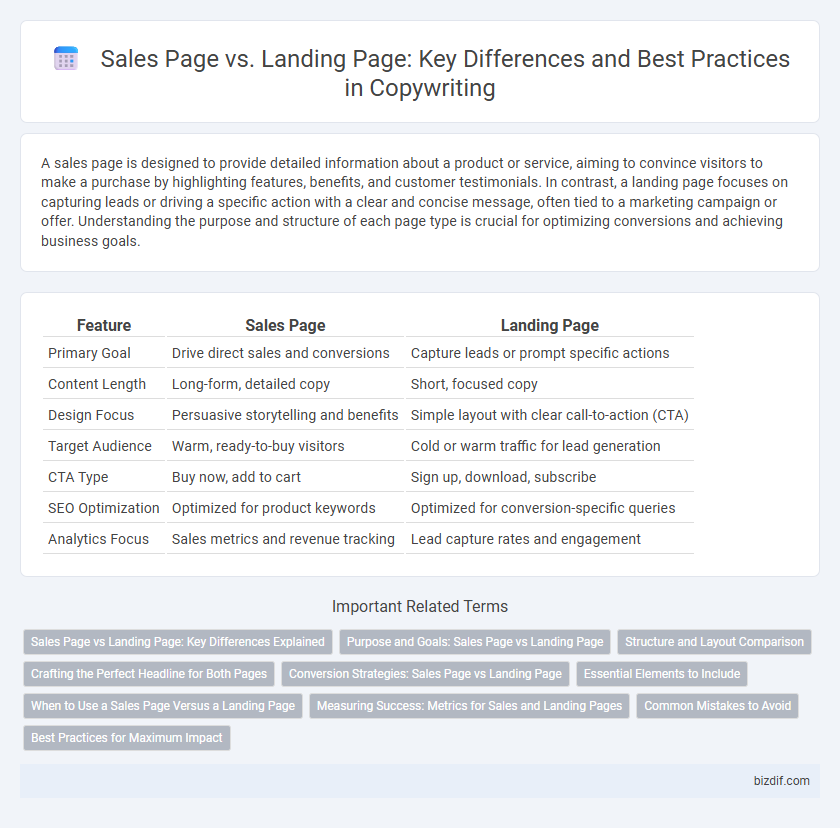A sales page is designed to provide detailed information about a product or service, aiming to convince visitors to make a purchase by highlighting features, benefits, and customer testimonials. In contrast, a landing page focuses on capturing leads or driving a specific action with a clear and concise message, often tied to a marketing campaign or offer. Understanding the purpose and structure of each page type is crucial for optimizing conversions and achieving business goals.
Table of Comparison
| Feature | Sales Page | Landing Page |
|---|---|---|
| Primary Goal | Drive direct sales and conversions | Capture leads or prompt specific actions |
| Content Length | Long-form, detailed copy | Short, focused copy |
| Design Focus | Persuasive storytelling and benefits | Simple layout with clear call-to-action (CTA) |
| Target Audience | Warm, ready-to-buy visitors | Cold or warm traffic for lead generation |
| CTA Type | Buy now, add to cart | Sign up, download, subscribe |
| SEO Optimization | Optimized for product keywords | Optimized for conversion-specific queries |
| Analytics Focus | Sales metrics and revenue tracking | Lead capture rates and engagement |
Sales Page vs Landing Page: Key Differences Explained
A sales page is designed to drive a direct purchase by providing detailed product information, benefits, and persuasive calls to action, whereas a landing page focuses on capturing leads by encouraging visitors to complete a specific goal such as signing up or downloading content. Sales pages often contain extensive copy, testimonials, and pricing, aiming to convert visitors into customers, while landing pages maintain a minimalist design to reduce distractions and maximize conversion rates for a single objective. Understanding the distinct purpose and structure of sales pages versus landing pages allows marketers to optimize their campaigns for higher engagement and conversion efficiency.
Purpose and Goals: Sales Page vs Landing Page
Sales pages are designed to drive direct purchases by providing detailed product information, persuasive copy, and clear calls-to-action to convert visitors into paying customers. Landing pages focus on capturing leads or encouraging specific actions, such as sign-ups or downloads, by minimizing distractions and highlighting a single offer or value proposition. Understanding these distinct purposes helps optimize conversion strategies based on whether the goal is immediate sales or lead generation.
Structure and Layout Comparison
Sales pages typically feature long-form content with detailed product descriptions, testimonials, and multiple calls-to-action designed to guide visitors through the buying decision. Landing pages focus on brevity and clarity, often using a single call-to-action, concise headlines, and minimal distractions to drive immediate conversions. Structurally, sales pages rely on storytelling and persuasive elements, while landing pages prioritize simplicity and direct user engagement through clean, focused layouts.
Crafting the Perfect Headline for Both Pages
Crafting the perfect headline for a sales page requires clear, persuasive language that highlights the product's key benefits and addresses the target audience's pain points to drive conversions. For a landing page, the headline must be concise and focused on a single, compelling call to action that captures visitor attention immediately and encourages click-throughs. Both headlines should incorporate strong keywords relevant to the product or offer to enhance SEO and improve overall page performance.
Conversion Strategies: Sales Page vs Landing Page
Sales pages prioritize detailed storytelling, persuasive copy, and multiple calls-to-action to guide visitors through a comprehensive buying journey, boosting conversion rates by addressing objections and highlighting benefits. Landing pages focus on targeted messaging and a single, clear call-to-action designed for rapid lead capture or purchase, optimizing conversion by minimizing distractions. Effective conversion strategies depend on aligning the page format with user intent, product complexity, and funnel stage to maximize engagement and sales.
Essential Elements to Include
Effective sales pages feature compelling headlines, clear value propositions, and persuasive calls to action designed to drive conversions. Landing pages prioritize focused content, concise messaging, and minimal distractions to capture leads or prompt specific user actions. Both require trust signals such as testimonials and guarantees to build credibility and encourage engagement.
When to Use a Sales Page Versus a Landing Page
Use a sales page when the goal is to provide detailed product information, address objections, and persuade visitors to make a purchase directly on the page. Opt for a landing page when capturing leads through a simple, focused call-to-action is the priority, such as signing up for a newsletter or downloading an ebook. Sales pages are ideal for complex offers requiring explanation, while landing pages suit campaigns aiming for quick conversions with minimal distractions.
Measuring Success: Metrics for Sales and Landing Pages
Sales pages primarily measure success through conversion rates, average order value, and customer acquisition cost, reflecting their focus on driving purchases. Landing pages track metrics such as click-through rates, bounce rates, and lead generation effectiveness, optimizing for initial visitor engagement and data capture. Analyzing these distinct KPIs enables marketers to tailor copywriting strategies that enhance performance for each page type.
Common Mistakes to Avoid
Confusing sales pages with landing pages often leads to diluted messaging and lower conversion rates, as sales pages require detailed persuasion while landing pages demand focused, concise content. Neglecting to tailor headlines and calls-to-action for the specific page purpose significantly reduces user engagement and clarity. Overloading landing pages with excessive information common on sales pages can overwhelm visitors, causing high bounce rates and missed lead opportunities.
Best Practices for Maximum Impact
Optimize sales pages with persuasive headlines, clear value propositions, and strong calls-to-action (CTAs) to boost conversions effectively. Landing pages perform best when tailored to specific campaigns, featuring minimal distractions, concise content, and strategically placed forms for lead capture. Employ A/B testing and user analytics to continuously refine copy, design, and layout for maximum engagement and ROI.
Sales Page vs Landing Page Infographic

 bizdif.com
bizdif.com